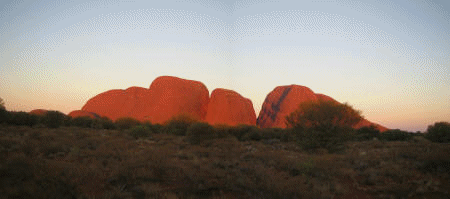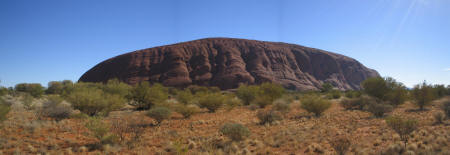Travel News - Northern Territory
26 March - 27 March, 2005 - Kata Tjuta (Olgas) - Uluru (Ayres Rock)
|
After travelling along the Great Central Road, we finally arrived in the Northern Territory. We still had 200 km to drive on red dirt road before we reached Kata Tjuta. We caught the first glimpse of the 450 metre high Kata Tjuta formations about 20 km away. Kata Tjuta is a group of massive rocks. The highest rock is 450 metres high, which is actually higher than Uluru, but the individual rocks are much smaller in size. We arrived just before sunset so we watched the famous changing colours as the sun sets. |
Nach hunderten Kilometern Schotterstrasse kommen wir zu unglaublich rotoranger Schotterstrasse mit Kata Tjuta bzw. Olgas im Hintergrund. Von der Schotterstrasse kommen wir auf leisen Asphalt, was ein sicheres Zeichen dafür ist, dass wir uns einer Touristenhochburg nähern. Kata Tjuta ist eine Formation von mehreren Felsbrocken die etwa 50 Kilometer von Uluru bzw. Ayers Rock entfernt sind. Kata Tjuta ist wahrscheinlich nicht so bekannt wie Uluru dafür höher. |
|
Watching the sunsets at Kata Tjuta and Uluru is one of the most popular tourist activities in the area. Although the tourist hoards are often more annoying than the flies, it is interesting watching the colour of the rocks change during the half hour as the sun sets. You can also watch sunrises, but strangely most people do the sunsets instead of the 05.30 am sunrises. |
Nach perfektem timing geniessen wir unser Abendessen vor Kata Tjuta und bewundern den Sonnenuntergang. Es ist einfach faszinierend, wie sich die Felsfarbe sekundenweise ändert mit dem sich ändernden Winkel der Sonneneinstrahlung durch die untergehende Sonne. Schaut mal, was Karl für Euch gezaubert hat. |

|
We camped overnight at Yulara which is the Uluru resort. There are not many other options available, except for the different hotels rooms and apartments that are offered within the Yulara Resort. The following day we returned to Kata Tjuta and did the Valley of the Winds 8 km loop track that weaves through the ensemble of rock formations. This was a nice walk. It was about 33 degrees, so it was hot but not excessive. |
Da es bekanntlich nach dem Sonnenuntergang dunkel ist, haben wir unser Zelt 'blind' in Yulara aufgestellt, worin wir mittlerweile wirklich geübt sind. Es ist Karsamstag, ob das etwas damit zutun hat, dass die Grasfläche mit unzähligen Hasen bevölkert ist oder doch ein Ostergeschenk. Grasfläche, ja wir sind in der Mitte von Australien und im Resort Yulara gibt es Grasflächen zum Zelten. Yulara ist ein Resort mit Geschäften, Banken, Post und allem was man so braucht. Der nächste Ort ist Alice Springs, 450 Kilometer entfernt. |
|
It's hard to experience it in the photos, but you just have to try and imagine the presence of the large stone formations, the earth red colours and the dry heat that embrace you here. Its a fascinating landscape and climate. Although it is harsh there is an abundance of wildlife, if you take the time to notice it when passing by. We met a spiny-tailed gecko along the track that was trying to catch the flies around the camera while I took a photo. |
Vom Westen kommend haben wir eine Zeitverschiebung von 90 Minuten. Wir versuchen früh aufzustehen. Halb verschlafen machen wir uns auf den 8 km Valley of the Winds Walk, der um einen der Felsen von Kata Tjuta führt. Die Felsen haben eine relativ glatte Oberfläche aber das ist nicht der einzige Grund, warum man auf den Felsen nicht klettern soll. Die Region hier ist heilig für Aborigines. Sie verbieten niemandem hineinzugehen, bitten jedoch das Land zu achten. |

|
I visited the region around Uluru and Kata Tjuta 23 years ago and remember wanting to do the walk around Kata Tjuta. So now I have done it. Alot has changed in this region since I visited as a teenager. There is alot more aboriginal presence since everything has been handed back to the aborigines. The Cultural Centre at Uluru is quite good. It has some interesting aboriginal cultural stories and all decorated with beautiful aboriginal paintings. You can't take photos in the cultural centre so you'll just have to visit yourself. All the roads in the area are sealed (bitumen), not like 23 years ago. The presence of Uluru is also inspiring as you drive around in the area. It is really an amazing stone and you can easily experience how the aborigines feel spiritual about this place, even if it has now become one of the premium tourist destinations in Australia. It is also very expensive at $25 per person to enter the park, it must be the most expensive National Park in Australia (by at least a factor of 5). |
Es ist unglaublich, wie sich die Tiere an die Umgebung anpassen. Der kleine Gecko auf dem Foto oben ist fast nicht zu sehen. Das war ein ziemlich neugieriger und wahrscheinlich hungriger Kerl. Er war mehr an den Fliegen interessiert, die sich auf der Kamera niederlassen. Wirklich bekannt für das Zentrum von Australien ist Uluru bzw. Ayers Rock. Kata Tjuta ist wirklich faszinierend, Uluru ist ein riesiger Fels der von einer Ebene so weit das Auge reicht in die Höhe emporsteigt. Die bekannten Fotos vermitteln den Eindruck, dass der Fels länglich ist. Von der Vogelperspektive betrachtet hat Uluru eine HerzForm. Es gibt einen Weg und eine Strasse rund um Uluru. Ein paar aboriginal Geschichten rund um Uluru sind bekannt, aber die meisten Geschichten dürfen nur an spezielle Aborigines überliefert werden. An einer Stelle kann man auf der Felsoberfläche die Spur von eine Schlange sehen, die dabei ist eine andere Schlange anzugreifen. Ein paar Sträucher, die giftig sind wurden dies durch die Wut von einer der Schlangen. |

|
So here are the typical, well-known photos of Uluru. One from the front and one from the back. We drove around the 15 km circumference road looking at all the different angles. There are many sacred sites around the rock where the aborigines request that you don't take photos. For the Aborigines, photos remove a part of the landscape from its surrounding region. They believe that sacred sites should not be disturbed and no part of a sacred site (physical or imaginative) should be removed from its surrounding area. |
Um etwas Einblick in die aboriginal Kultur zu bekommen gibt es ein Kulturzentrum in der Nähe von Uluru. Es ist wirklich empfehlenswert sich die nicht nur mit aboriginal Malereien schön gestaltete, sondern auch sehr informative Ausstellung anzusehen. Man kann sich mit den anwesenden Rangern unterhalten und mehr von der Gegend erfahren oder die Steine und Briefe durchforsten die an Uluru aus schlechtem Gewissen zurückgeschickt wurden. Leute die ein Stück Fels von Uluru mitgenommen haben glaubten, dass ihr Pech im Leben, darauf zurückzufürhen ist. Aboriginees sind zwar traurig wenn geheiligte Stätten gestört oder beschädigt werden, sie würden jedoch nie jemanden verurteilen. |
|
You can see by the above photos that sunset viewing at Uluru is a tourist activity. We stayed another hour after the sunset viewing to view the moon rise. When we were at Uluru, it was just after full moon, so we had wonderful views of the rock in moonlight. The added advantage was that the carpark was empty because all the tourist go back to the hotel. It was very peaceful waiting for the moon to rise, and what a romantic experience ! Some extra views around Uluru of the caves and waterholes are shown below. These were not the really sacred sites, so photos were ok, for all you superstitious types. Although they still are important sites for the Aborigines |
Der Sonnenaufgang und Sonnenuntergang sind wichtige Touristenattraktionen wofür es eigene Aussichtsparkplätze gibt, die natürlich von Touristen bevölkert sind. Es ist auch einzigartig, die sich änderende Felsfarbe zu beobachten. Wir hatten Glück, dass der Mond nur eine Stunde nach Sonnenuntergang aufgegangen ist. Das Warten hat sich wahrlich gelohnt. Aborigines bitten Uluru nicht zu besteigen. Als geheiligte Stätte ist es vergleichbar mit einer Kirche. Der Aufstieg ist an der blanken Felswand entlang einer Kette möglich, was recht gefährlich aussieht. Wir sind am Boden geblieben und haben uns hier den Fels näher angesehen. |

Next Report : 28 March - 29 March, 2005 - Kings Canyon